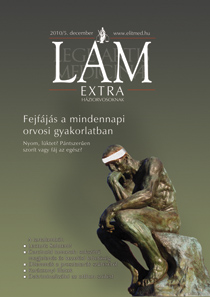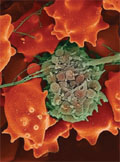The eLitMed.hu medical portal uses computer cookies for convenient operation. Detailed information can be found in the Cookie-policy.
LAM Extra for General Practicioners - 2010;2(05)
Content
[ON RIVAROXABANS MECHANISM OF EFFECT]
[A new era of anticoagulant therapy is approaching. No new oral anticoagulants have been introduced for seventy years. However, two large groups of anticoagulants (molecules with anti-FXa and anti-FIIa acitivity) are currently at advanced stages of clinical trials. This publication summarises the most important information on the mechanism of effect of the anti-FXa drug rivaroxaban. The possible advantages of the “direct” effect and the anti-FXa effect are emphasized. The most significant drug interactions of the new anticoagulant are also presented.]
[HEADACHE IN EVERYDAY MEDICAL PRACTICE]
[Headache is one of the most common complaints in clinical practice. The International Headache Society’s current classification distinguishes two major categories of headache: primary and secondary (symptomatic) headache types. The former types, which account for the majority of headaches, are caused by a functional disorder in a structurally intact nervous system and are characterised by stereotypical attacks that resolve - in most cases - spontaneously after a certain period, the duration of which is characteristic for each headache type. The diagnosis of primary headaches is based on a detailed history of the attacks and negative results on a neurological examination. At the first presentation of the patient, it should be determined whether a potentially serious or life-threatening condition might be present, whether the type of the patient’s headache can be ascertained according to the IHS’s criteria, and what kind of examinations are needed to establish the correct diagnosis. A detailed history is the cornerstone of the diagnosis of primary headaches and it cannot be substituted by instrumental examinations. The use of imaging and other examination methods is necessary for the diagnosis of secondary headaches, but if the patient’s history and the results of the neurological investigation are fully consistent with a primary headache type, instrumental examinations are unlikely to provide any additional information. Although establishing the correct diagnosis is often time-consuming, it is necessary for the efficient treatment.]
1.
Clinical Neuroscience
[Headache registry in Szeged: Experiences regarding to migraine patients]2.
Clinical Neuroscience
[The new target population of stroke awareness campaign: Kindergarten students ]3.
Clinical Neuroscience
Is there any difference in mortality rates of atrial fibrillation detected before or after ischemic stroke?4.
Clinical Neuroscience
Factors influencing the level of stigma in Parkinson’s disease in western Turkey5.
Clinical Neuroscience
[The effects of demographic and clinical factors on the severity of poststroke aphasia]1.
2.
Clinical Oncology
[Pancreatic cancer: ESMO Clinical Practice Guideline for diagnosis, treatment and follow-up]3.
Clinical Oncology
[Pharmacovigilance landscape – Lessons from the past and opportunities for future]4.
5.





